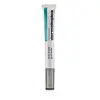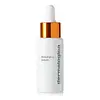What's inside
What's inside
 Key Ingredients
Key Ingredients

 Benefits
Benefits

 Concerns
Concerns

 Ingredients Side-by-side
Ingredients Side-by-side

Water
Skin ConditioningButylene Glycol
HumectantHamamelis Virginiana Water
AstringentIsopropyl Lauroyl Sarcosinate
Skin ConditioningNiacinamide
SmoothingPropanediol
SolventSalicylic Acid
MaskingPolyacrylate Crosspolymer-6
Emulsion StabilisingCaprylyl Methicone
Skin ConditioningGlycereth-26
HumectantSaccharide Isomerate
HumectantHexylresorcinol
AntimicrobialSalvia Sclarea Oil
MaskingMalic Acid
BufferingAloe Barbadensis Leaf Extract
EmollientSalvia Sclarea Extract
AntiseborrhoeicLavandula Angustifolia Oil
MaskingCitrus Limon Peel Oil
MaskingRosmarinus Officinalis Leaf Oil
MaskingLavandula Hybrida Oil
EmollientSclerotium Gum
Emulsion StabilisingSodium Carrageenan
Emulsion StabilisingThymol
AntimicrobialTerpineol
MaskingPullulan
Lecithin
EmollientGlycerin
HumectantDimethyl Isosorbide
SolventPEG-12 Dimethicone/PPG-20 Crosspolymer
Xanthan Gum
EmulsifyingSodium Citrate
BufferingEthylhexylglycerin
Skin ConditioningTetrasodium Glutamate Diacetate
Silica
AbrasiveTocopherol
AntioxidantSea Salt
AbrasivePotassium Sorbate
PreservativeSodium Benzoate
MaskingSodium Hydroxide
BufferingCitric Acid
BufferingBenzoic Acid
MaskingAminomethyl Propanol
BufferingLimonene
PerfumingLinalool
PerfumingPhenoxyethanol
PreservativeWater, Butylene Glycol, Hamamelis Virginiana Water, Isopropyl Lauroyl Sarcosinate, Niacinamide, Propanediol, Salicylic Acid, Polyacrylate Crosspolymer-6, Caprylyl Methicone, Glycereth-26, Saccharide Isomerate, Hexylresorcinol, Salvia Sclarea Oil, Malic Acid, Aloe Barbadensis Leaf Extract, Salvia Sclarea Extract, Lavandula Angustifolia Oil, Citrus Limon Peel Oil, Rosmarinus Officinalis Leaf Oil, Lavandula Hybrida Oil, Sclerotium Gum, Sodium Carrageenan, Thymol, Terpineol, Pullulan, Lecithin, Glycerin, Dimethyl Isosorbide, PEG-12 Dimethicone/PPG-20 Crosspolymer, Xanthan Gum, Sodium Citrate, Ethylhexylglycerin, Tetrasodium Glutamate Diacetate, Silica, Tocopherol, Sea Salt, Potassium Sorbate, Sodium Benzoate, Sodium Hydroxide, Citric Acid, Benzoic Acid, Aminomethyl Propanol, Limonene, Linalool, Phenoxyethanol
Water
Skin ConditioningGlycerin
HumectantButylene Glycol
HumectantEthoxydiglycol
HumectantLactic Acid
BufferingSalvia Hispanica Seed Extract
EmollientSodium PCA
HumectantPalmitoyl Tripeptide-5
Skin ConditioningSophora Japonica Flower Extract
Skin ProtectingAscorbyl Methylsilanol Pectinate
AntioxidantSodium Hyaluronate
HumectantTocopherol
AntioxidantDipotassium Glycyrrhizate
HumectantAminopropyl Ascorbyl Phosphate
AntioxidantTrehalose
HumectantPolyacrylate-13
Propanediol
SolventCitrus Grandis Peel Oil
MaskingHelianthus Annuus Seed Oil
EmollientPolyisobutene
Methylpropanediol
SolventCarrageenan
Pentylene Glycol
Skin ConditioningGlyceryl Polyacrylate
Caprylyl Glycol
EmollientEthylhexylglycerin
Skin ConditioningTetrasodium Glutamate Diacetate
Xanthan Gum
EmulsifyingPolysorbate 20
EmulsifyingLimonene
PerfumingSodium Hydroxide
BufferingPhenoxyethanol
PreservativeWater, Glycerin, Butylene Glycol, Ethoxydiglycol, Lactic Acid, Salvia Hispanica Seed Extract, Sodium PCA, Palmitoyl Tripeptide-5, Sophora Japonica Flower Extract, Ascorbyl Methylsilanol Pectinate, Sodium Hyaluronate, Tocopherol, Dipotassium Glycyrrhizate, Aminopropyl Ascorbyl Phosphate, Trehalose, Polyacrylate-13, Propanediol, Citrus Grandis Peel Oil, Helianthus Annuus Seed Oil, Polyisobutene, Methylpropanediol, Carrageenan, Pentylene Glycol, Glyceryl Polyacrylate, Caprylyl Glycol, Ethylhexylglycerin, Tetrasodium Glutamate Diacetate, Xanthan Gum, Polysorbate 20, Limonene, Sodium Hydroxide, Phenoxyethanol
 Reviews
Reviews

Ingredients Explained
These ingredients are found in both products.
Ingredients higher up in an ingredient list are typically present in a larger amount.
Butylene Glycol (or BG) is used within cosmetic products for a few different reasons:
Overall, Butylene Glycol is a safe and well-rounded ingredient that works well with other ingredients.
Though this ingredient works well with most skin types, some people with sensitive skin may experience a reaction such as allergic rashes, closed comedones, or itchiness.
Learn more about Butylene GlycolEthylhexylglycerin (we can't pronounce this either) is commonly used as a preservative and skin softener. It is derived from glyceryl.
You might see Ethylhexylglycerin often paired with other preservatives such as phenoxyethanol. Ethylhexylglycerin has been found to increase the effectiveness of these other preservatives.
Glycerin is already naturally found in your skin. It helps moisturize and protect your skin.
A study from 2016 found glycerin to be more effective as a humectant than AHAs and hyaluronic acid.
As a humectant, it helps the skin stay hydrated by pulling moisture to your skin. The low molecular weight of glycerin allows it to pull moisture into the deeper layers of your skin.
Hydrated skin improves your skin barrier; Your skin barrier helps protect against irritants and bacteria.
Glycerin has also been found to have antimicrobial and antiviral properties. Due to these properties, glycerin is often used in wound and burn treatments.
In cosmetics, glycerin is usually derived from plants such as soybean or palm. However, it can also be sourced from animals, such as tallow or animal fat.
This ingredient is organic, colorless, odorless, and non-toxic.
Glycerin is the name for this ingredient in American English. British English uses Glycerol/Glycerine.
Learn more about GlycerinLimonene is a fragrance that adds scent and taste to a formulation.
It's found in the peel oil of citrus fruits and other plants such as lavender and eucalyptus. The scent of limonene is generally described as "sweet citrus".
Limonene acts as an antioxidant, meaning it helps neutralize free radicals.
When exposed to air, oxidized limonene may sensitize the skin. Because of this, limonene is often avoided by people with sensitive skin.
The term 'fragrance' is not regulated in many countries. In many cases, it is up to the brand to define this term. For instance, many brands choose to label themselves as "fragrance-free" because they are not using synthetic fragrances. However, their products may still contain ingredients such as essential oils that are considered a fragrance.
Learn more about LimonenePhenoxyethanol is a preservative that has germicide, antimicrobial, and aromatic properties. Studies show that phenoxyethanol can prevent microbial growth. By itself, it has a scent that is similar to that of a rose.
It's often used in formulations along with Caprylyl Glycol to preserve the shelf life of products.
Propanediol is an all-star ingredient. It softens, hydrates, and smooths the skin.
It’s often used to:
Propanediol is not likely to cause sensitivity and considered safe to use. It is derived from corn or petroleum with a clear color and no scent.
Learn more about PropanediolSodium Hydroxide is also known as lye or caustic soda. It is used to adjust the pH of products; many ingredients require a specific pH to be effective.
In small amounts, sodium hydroxide is considered safe to use. However, large amounts may cause chemical burns due to its high alkaline.
Your skin has a natural pH and acid mantle. This acid mantle helps prevent harmful bacteria from breaking through. The acid mantle also helps keep your skin hydrated.
"Alkaline" refers to a high pH level. A low pH level would be considered acidic.
Learn more about Sodium HydroxideTetrasodium Glutamate Diacetate is a chelating agent. Chelating agents help prevent metal ions from binding to other ingredients. This helps prevent unwanted effects and reactions from a product. These metal ions may come from water and are found in miniscule amounts.
Tetrasodium Glutamate Diacetate can also help other preservatives be more effective.
Tocopherol (also known as Vitamin E) is a common antioxidant used to help protect the skin from free-radicals and strengthen the skin barrier. It's also fat soluble - this means our skin is great at absorbing it.
Vitamin E also helps keep your natural skin lipids healthy. Your lipid skin barrier naturally consists of lipids, ceramides, and fatty acids. Vitamin E offers extra protection for your skin’s lipid barrier, keeping your skin healthy and nourished.
Another benefit is a bit of UV protection. Vitamin E helps reduce the damage caused by UVB rays. (It should not replace your sunscreen). Combining it with Vitamin C can decrease sunburned cells and hyperpigmentation after UV exposure.
You might have noticed Vitamin E + C often paired together. This is because it is great at stabilizing Vitamin C. Using the two together helps increase the effectiveness of both ingredients.
There are often claims that Vitamin E can reduce/prevent scarring, but these claims haven't been confirmed by scientific research.
Learn more about TocopherolWater. It's the most common cosmetic ingredient of all. You'll usually see it at the top of ingredient lists, meaning that it makes up the largest part of the product.
So why is it so popular? Water most often acts as a solvent - this means that it helps dissolve other ingredients into the formulation.
You'll also recognize water as that liquid we all need to stay alive. If you see this, drink a glass of water. Stay hydrated!
Learn more about WaterXanthan gum is used as a stabilizer and thickener within cosmetic products. It helps give products a sticky, thick feeling - preventing them from being too runny.
On the technical side of things, xanthan gum is a polysaccharide - a combination consisting of multiple sugar molecules bonded together.
Xanthan gum is a pretty common and great ingredient. It is a natural, non-toxic, non-irritating ingredient that is also commonly used in food products.
Learn more about Xanthan Gum